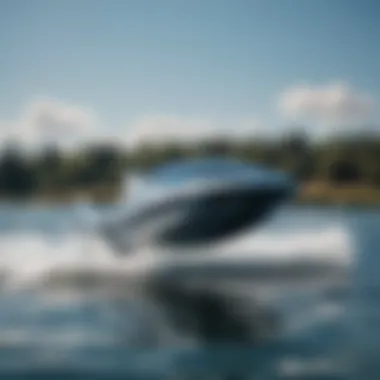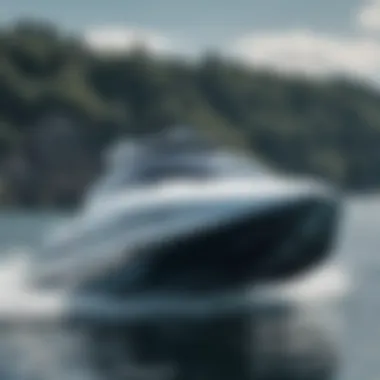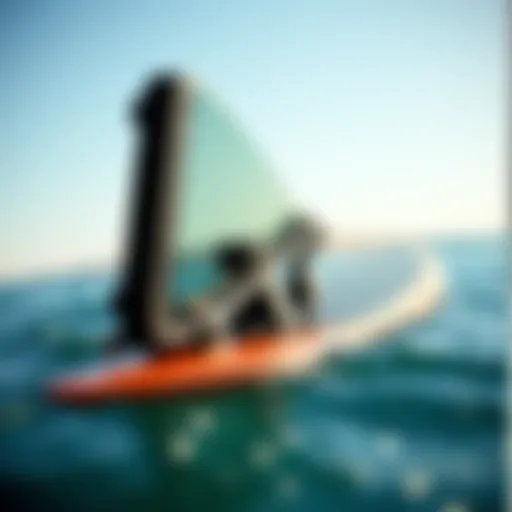Exploring the Electric Hydrofoil Market: A New Wave of Adventure


Intro
The electric hydrofoil market is making waves in the water sports scene, especially among kiteboarding enthusiasts. With advancements in design and technology, these innovative watercraft are not just a novelty; they offer a unique experience that blends adventure with modern engineering. As more people seek out exhilarating ways to enjoy the water, electric hydrofoils have emerged as a potent contender in the realm of aquatic activities.
Navigating through the voluminous options may seem daunting. When you're knee-deep in choices and tech specifications, understanding the essentials becomes crucial. This guide pulls back the curtain on all things electric hydrofoil—from the core attributes that set these machines apart, to practical tips on how to maintain them and, of course, expert techniques to enhance your riding skills.
As the popularity rises, so does the necessity for potential buyers to sift through myriad features and purchase considerations. You'll want to know what makes a model suitable for your level of expertise and riding style. This article aims to empower kiteboarding aficionados, providing insight that will steer you toward the right decisions on this dynamic journey.
Dive in, and let’s unearth the nuances that define this buoyant and electrifying market.
Understanding Electric Hydrofoils
Understanding electric hydrofoils is crucial for anyone considering diving into this innovative watercraft technology. As kiteboarding enthusiasts seek new ways to amplify their time on the water, electric hydrofoils present a unique opportunity. These devices, which lift above the water’s surface, provide a seamless glide, allowing riders to experience speed and agility like never before. By grasping the intricacies of electric hydrofoils, potential buyers can make informed decisions when selecting the right model for their needs, ensuring they get the most bang for their buck.
What is an Electric Hydrofoil?
An electric hydrofoil is essentially a surfboard mounted with a hydrofoil and powered by an electric motor. This design allows the board to ascend above the water once it reaches a certain speed, reducing drag and creating a smoother ride. When you think of electric hydrofoils, imagine gliding effortlessly through the water, unbothered by the surface’s choppy waves. It’s like flying over water, freeing riders from the limitations that traditional boards often face. It’s not just another toy; it’s a tech-savvy companion for outdoor adventure lovers.
How Electric Hydrofoils Work
The workings of an electric hydrofoil may seem complex at first glance, but it boils down to a few key components. At the heart of the hydrofoil is the motor, which is hidden underwater. When you press the throttle, the motor kicks in, propelling the rider forward. As the speed picks up, the hydrofoil's wings create lift, raising the board above the water’s surface.
- Motor: Most electric hydrofoils use brushless motors for efficiency.
- Battery: Lithium-ion batteries are commonly used, providing the necessary power for extended rides.
- Control System: A handheld remote typically manages the speed and direction, giving riders complete control over their experience.
Understanding how these components interrelate helps buyers appreciate the performance capabilities of various models and assess which suits their riding style best.
Comparison with Traditional Hydrofoils
Traditional hydrofoils rely on the rider’s strength, skill, and external wind or wave energies to achieve lift and speed. In contrast, electric hydrofoils have a mechanical edge, offering a more consistent ride and minimizing the physical effort required.
Here’s a more detailed comparison:
- Ease of Use: Electric hydrofoils are generally easier for beginners due to their powered nature. Traditional hydrofoils require a steeper learning curve.
- Ride Conditions: With electric hydrofoils, you can ride in a wider range of conditions without worrying about wind strengths.
- Experience: Traditional hydrofoiling can be a thrilling experience for those who love kiteboarding’s physical aspects, but electric hydrofoils bring a different kind of thrill by embracing a sense of weightlessness.
In summary, understanding electric hydrofoils is key to fully appreciating their place in the water sport world. They offer a modern twist on a classic craft, making waves among adventurers who seek new experiences on the water.
Features to Consider
When looking into electric hydrofoils, it becomes critically important to focus on the features that can vastly influence your riding experience. Understanding these elements can not only help you make a well-informed choice but also enhance your overall enjoyment and performance on the water. So, let’s dive into the essential features you should keep in mind as you explore the electric hydrofoil market.
Motor Power and Efficiency
The first thing that usually comes to mind with electric hydrofoils is the motor. A powerful motor can mean the difference between gliding effortlessly above the water and struggling to catch that ideal lift. Look for motors that have between 5 to 20 horsepower, as the range often dictates the speed and performance of the craft.
Efficiency is equally key; a motor that consumes less power while delivering the same thrust can significantly extend your battery life. Some manufacturers focus on developing robust propulsion systems that maximize thrust without draining the battery too quickly.
Battery Life and Charging Options
No one enjoys cutting short a ride because their battery sputtered out. Therefore, battery life stands tall as a significant factor when selecting an electric hydrofoil. It’s smart to consider units that offer at least 60 minutes of ride time at optimal speeds. Meanwhile, charging options can be another make-or-break criterion.


Some batteries can be charged in as little as an hour, while others may take up to four. Look for systems that feature either swappable batteries or quick charging, especially if you plan on spending extended periods out on the water.
Weight and Portability
Weight isn’t just a minor detail; it has major implications on both performance and maneuverability. Lighter hydrofoils can offer a more responsive and lively ride, making it easier for riders to perform tricks or navigate tight corners. However, a lighter design sometimes compromises durability, which is where the right balance comes into play.
Portability is another aspect, especially for kiteboarders who may need to transport their gear. Consider how easily the hydrofoil can be assembled and disassembled, and whether it can be carried with minimal fuss to the launch site.
Construction Materials
The materials used in the construction of electric hydrofoils heavily influence not only their weight and portability but also their durability and performance. Common materials like carbon fiber, aluminum, and high-density plastics each have their pros and cons.
- Carbon Fiber: Known for being lightweight and very strong but comes at a higher cost.
- Aluminum: Usually offers a good balance of weight and strength at a more attainable price point.
- High-Density Plastics: These can be incredibly durable but may add extra weight.
Ultimately, the choice of materials can affect your riding experience and how long your hydrofoil holds up against the test of time. It’s worth researching which materials best suit your riding style and anticipated usage.
When it comes to electric hydrofoils, every detail matters. From motor power to construction materials, the right features can transform your adventures on the water.
Top Electric Hydrofoils Available
Understanding the top electric hydrofoils on the market is a crucial step for any kiteboarding enthusiast looking to elevate their water-powered experiences. With an increasing number of brands and models out there, knowing which beginners or seasoned riders recommend can significantly affect your overall satisfaction and performance.
The electric hydrofoil market attracts many with a promise of easy gliding over the water and the thrill of powered flight. However, not all options are created equal; factors such as build quality, motor efficiency, battery longevity, and price point all come into play. Determining what works for your specific needs can be a game changer.
Leading Brands in the Market
In the realm of electric hydrofoils, several brands stand out as leaders, each with its history and approach to design. Look no further than Lift Foils—pioneers who arguably started the electric hydrofoil craze. Their boards are renowned for precision engineering and user-friendly mechanics. Then there's Fliteboard, which kicked up a storm with its flashy designs and intuitive controls.
Another contender worth mentioning is Waydoo. Known for pushing the envelope on affordability without skimping on quality, they’ve managed to grab attention with performance boards appealing to both neophytes and pros alike. One can't overlook eFoil, which has become almost synonymous with the sport due to their high-tech features and stylistic flair. Each of these brands offers a variety of models catering to everyone from beginners to expert riders.
Budget-Friendly Options
Not everyone can throw a heap of cash at a hydrofoil right away; thus, budget-friendly options are essential. Some brands excel in providing solid performance without breaking the bank. Waydoo stands out here, with models that don't compromise on features, letting folks enjoy the experience without excessive investment. Another notable mention is Lift Foils's introductory range, which has designed a model that allows entry into the electric hydrofoil world at a reasonable price.
For around two to three thousand dollars, options like the Rider or Manta from Waydoo can get you up and flying above the water without a hefty price tag. Invitation takes a front row seat in their designs, making it easier for those new to the watersport scene.
High-End Electric Hydrofoils
On the opposite end of the spectrum, high-end electric hydrofoils cater to those seeking top-tier performance and cutting-edge technology. For instance, Fliteboard offers various premium models that boast exceptional speed and battery life. Moreover, their customization options mean serious riders can get exactly what they want. The eFoil by Lift Foils is another name that carries heft in the minds of enthusiasts; formidable performance capabilities meet sleek design, truly catering to high-performance lovers.
Investing in models that can soar above $10,000 might sound daunting, but for seasoned riders, these boards offer unparalleled quality and performance. Those willing to commit to the premium price can reap rewards in both longevity and excitement on the water.
"The right electric hydrofoil can make the difference between a tiring day on the water and the thrill of effortless gliding."
Choosing the right electric hydrofoil is part science, part art. Weighing all options—brands, costs, and design—is vital to making a call that fits your riding style and budget.
Purchasing Considerations
When diving into the electric hydrofoil market, it's to keep in mind various purchasing considerations. This guide aims to provide kiteboarders, instructors, and water sports enthusiasts not just the knowledge to select the right model, but also an understanding of the factors that will impact their overall satisfaction and performance.


Each electric hydrofoil offers unique characteristics, making the decision a reflection of your personal preferences and specific needs. The world of electric hydrofoiling is not just about having the latest gear; it's about choosing a product that aligns with your style and competencies on the water.
Where to Buy Electric Hydrofoils
Navigating where to buy an electric hydrofoil can be a maze. The options are vast, stretching from brick-and-mortar sporting goods stores to online marketplaces. Here are a few pathways to consider:
- Specialty Shops: Local shops that focus on aquatic sports often have a selection of electric hydrofoils and can provide personalized advice.
- Online Marketplaces: Websites like Amazon or eBay have a wide range of products from different brands, often with customer reviews that can guide your choice.
- Direct from Manufacturers: Companies that specialize in electric hydrofoils frequently operate their own websites, allowing direct purchase along with potential customer support benefits.
- Second Hand Platforms: For those who might be tight on budget, looking on platforms like Craigslist or Facebook Marketplace can lead to find deals, but one must be cautious with the condition of second-hand goods.
What to Look for in Reviews
Before making a purchase, it's vital to sift through product reviews. However, distinguishing valuable insights from fluff can be tricky. Here are some angles to consider in those reviews:
- Performance Feedback: Look for comments on speed, handling, and battery endurance. Personal experiences often highlight real-world performance.
- Durability Accounts: Check if users mention how well the hydrofoil held up over time, especially in various water conditions.
- Customer Service Experiences: Positive or negative reports about the manufacturer’s support can give you an idea of what to expect after your purchase.
- Comparison with Other Models: Some reviews also directly compare products, which can help clarify the pros and cons between different hydrofoils.
Understanding Warranty and Support
Finally, don’t overlook the warranty and support options that come with an electric hydrofoil. This aspect can save headaches down the road. Here are key points to consider:
- Warranty Length: A longer warranty often indicates the manufacturer's confidence in their product, so it's worth seeking options with robust coverage.
- What’s Covered: Understand precisely what defects are covered. Some warranties may cover structural issues but not electrical ones.
- Customer Support Access: Consider how you can reach out for support. Check for phone lines, chat options, or even forums where other users discuss solutions.
"Investing in a product with good support can mean the difference between a smooth experience and ongoing frustrations."
Whether you're excited to zip across the water or just keen to enhance your skills, these considerations are not merely checklists; they are stepping stones to making an informed choice that will enrich your time riding the waves. By navigating these aspects diligently, you're setting the stage for a more fulfilling hydrofoiling experience.
Performance and Experience
In the world of electric hydrofoils, performance and experience reign supreme. This hybrid watercraft offers not only the thrill of riding above water but also integrates cutting-edge technology to enhance user experience. This section will examine what makes riding an electric hydrofoil unique, the benefits it brings compared to traditional kiteboarding, and the crucial safety aspects necessary for a secure outing on the water.
Riding Experience on an Electric Hydrofoil
Riding an electric hydrofoil is like floating on a cloud skimming the water surface—there's a certain magic to it. The moment you engage the motor, you're lifted from the chop and waves; it's a feeling that’s hard to replicate with traditional setups. The sensation of gliding above water opens up new horizons, providing an unparalleled blend of speed and tranquility.
Throttle control plays a key role in how exhilarating or smooth your ride can be. Riders can experience varying levels of resistance depending on the motor power. Adjusting the throttle changes the uplift and speed. Those familiar with kiteboarding will appreciate this customizability. As the foil lifts, the sound of water dissipates, replaced by the hum of the motor—a sound some describe as a symphony of nature.
The joy doesn't just stem from speed; it’s about maneuverability. Modern hydrofoils allow for tighter turns and rapid shifts in direction, letting you carve through water with a fluid grace. But remember, mastering the board does take practice; it's a bit different when you're not just tethered to the wind.
Advantages Over Conventional Kiteboarding
The electric hydrofoil market is shifting the paradigm for kiteboarders, bringing several notable advantages. Here are a few to ponder:
- Extended Riding Hours: Without wind constraints, you can ride at any time of day. Early morning or late evening, the water is beckoning.
- Less Physical Exertion: Unlike kiteboarding, which demands strength to launch and harness the wind, electric hydrofoils lessen the physical strain. The motor assists in getting up and on the foil, making it accessible for all skill levels.
- No Need for Wind: Whether it's a calm day with no breeze or a stormy sea, the electric motor keeps you afloat. This opens up potential riding locales that wouldn't work for traditional kiteboarding.
"Electric hydrofoils give users a taste of freedom that traditional kiteboarding sometimes lacks. It's not just about the ride; it's about the experience."
— An avid hydrofoil enthusiast
Safety Considerations
With all its perks, riding an electric hydrofoil demands a focus on safety. Given the power of the equipment and the nature of water sports, it’s paramount to remain vigilant. Here’s a rundown of essential safety considerations:
- Wear a Life Jacket: Always have a well-fitted life jacket on. Even experienced riders can find themselves in unexpected situations.
- Know Your Limits: Start off slow. It’s tempting to push your speed limits, but striving for fast gains can lead to accidents.
- Check Equipment Regularly: Regular inspections of your board, battery, and motor can prevent malfunctions. Look out for any wear and tear.
- Be Aware of Surroundings: Always watch for other water activities, such as swimmers, paddleboarders, or boats. Stay well clear of crowded areas to avoid collisions.
- Educate Yourself on Emergency Protocols: Know what to do in case of a fall or unexpected dismount. Understanding the signal for help can be life-saving.


Navigating the waters on an electric hydrofoil can redefine your aquatic adventures. However, keeping safety at the forefront ensures enjoyable, worry-free experiences.
Maintenance and Care
In the realm of electric hydrofoils, maintenance and care play a pivotal role in ensuring longevity, performance, and, most importantly, safety. Just like a well-aligned kiteboard can elevate your riding experience, a properly maintained electric hydrofoil enhances efficiency and reliability on the water.
Caring for your electric hydrofoil involves a series of intentional practices, both in the short term and over the years. Ignoring this aspect can lead to pesky issues or even major malfunctions, which can hinder your adventures. Thus, having a grasp of daily maintenance tasks and long-term care is essential not just for the gear, but for the unforgettable experiences they facilitate.
Daily Maintenance Tips
Establishing a routine for daily maintenance can make a significant difference in your hydrofoil's performance. Here are some simple yet effective tips:
- Rinse and Dry: After every ride, flush your hydrofoil with fresh water to remove salt, sand, and debris. Be sure to dry it off to prevent corrosion and damage to the electronics.
- Inspect the Components: Look for signs of wear and tear on the propeller, motor, and foil itself. If anything looks out of order, it’s better to address it early.
- Charge Properly: Always follow the manufacturer's guidelines for charging. Overcharging your battery could shorten its life, while undercharging may lead to performance issues.
- Check for Loose Parts: Ensure that everything remains secure. A quick check before each ride can save a lot of trouble later.
- Store in a Cool, Dry Place: Instead of letting it bask in direct sunlight, keep your hydrofoil in a shaded environment. Extreme heat can negatively impact battery life.
Long-term Care Practices
When looking at long-term care, regular upkeep translates to better performance and potentially lower costs of expensive repairs. Here are some practices to consider:
- Professional Servicing: Schedule annual check-ups with a professional to ensure all components function correctly and are in good shape.
- Battery Management: Follow best practices for battery storage, such as discharging it to around 50% when not in use, and recharge it every few months to keep it healthy.
- Foil Care: Pay particular attention to the foil's condition. Any dents or damage could affect performance. Consider applying sealant or protective wax to keep it slick and free from scratches.
- Understand Material Vulnerabilities: Familiarize yourself with the specific construction materials of your hydrofoil. Composite and aluminum components, for instance, have unique maintenance needs.
- Monitor Software Updates: If your electric hydrofoil has smart features, stay updated with the software. This can enhance performance and fix potential bugs.
"Routine maintenance is the unsung hero of longevity, ensuring that your electric hydrofoil remains a reliable companion on the water."
Future Trends in Electric Hydrofoils
The landscape of electric hydrofoils is shifting, and keeping an eye on these developments can be crucial for both enthusiasts and instructors alike. Understanding the future trends can illuminate the broader trajectory of this technology, revealing insights that can shape purchasing decisions and riding experiences.
Technological Advancements
With rapid technological progress, electric hydrofoils are likely to see a number of improvements that will elevate performance and user experience. Here’s what to look out for:
- Battery Technology: Newer, more efficient batteries are emerging. Manufacturers are exploring lithium-sulfur and solid-state batteries which promise longer ride times and shorter charging durations. This kind of advancement could mean that a rider might soon be able to have a full day of fun on the water without worrying about battery life.
- Enhanced Control Systems: The integration of smart technologies, like sensor-driven control systems, can make steering easier and enhance stability at various speeds. Features such as automatic stabilization and customizable settings might cater to riders of different skill levels.
- Sustainable Materials: As environmental concerns rise, the industry may shift towards eco-friendly materials for constructing hydrofoils. The potential use of recycled composites could appeal to the conscientious rider, helping to make water sports more sustainable.
These advancements indicate a promising horizon that not only improves user experiences but also attracts new participants to this thrilling sport.
Market Growth Projections
Looking at the market from a broader perspective, the growth projections for electric hydrofoils are promising and present exciting opportunities:
- Consumer Trends: As watersport enthusiasts increasingly seek unique experiences, such advanced equipment is expected to gain traction. The 2019 report by Cork Growth Analytics indicated a significant rise in the number of active kitesurfers, and this trend is likely to carry on into future years as more people discover electric hydrofoils.
- Investment Opportunities: Increased investment in R&D could further pump up the market's growth. Companies are likely to merge innovation with marketing strategies to tap into wider demographics, making electric hydrofoils more accessible to novices and seasoned riders alike.
- Global Reach: Electric hydrofoils are gaining popularity beyond the bounds of traditional watersport hotspots. Regions with intense water-based leisure activities, such as the Mediterranean and Southeast Asia, are expected to see growing demand.
The potential for electric hydrofoils to revolutionize water sports isn’t just speculation; it's backed by steady innovation and a market eager for novel experiences.
The forward-looking trends in technology and market growth provide a context that is vital for kiteboarding enthusiasts. Keeping abreast of these changes not only enhances understanding but also equips riders with the knowledge to make informed decisions that will ensure a fulfilling experience on the water.
Finale
In this rapidly evolving landscape of watercraft technology, the segment of electric hydrofoils has carved a niche that is both enticing and complex. As discussed throughout this article, the significance of understanding electric hydrofoils cannot be overstated, especially for those who consider kiteboarding not just a sport, but a lifestyle.
The key elements covered provide a solid foundation for potential buyers. For example, knowing the technical specifications such as motor power, battery life, and weight can greatly influence performance on the water. Enthusiasts should weigh the advantages and drawbacks, both in their purchasing decisions and usage scenarios. Choosing the right hydrofoil isn’t merely picking the flashiest option; it’s about aligning with personal needs and preferences.
When it comes to the benefits highlighted, versatility stands out. Electric hydrofoils open up a world of experiences, allowing riders to glide over the water effortlessly. Those looking to push boundaries will find that the innovative features available enhance both fun and safety. Furthermore, understanding market trends and potential future developments can make all the difference in securing a product that remains relevant for years to come.
Another essential consideration discussed is the aspect of maintenance. Regular care ensures not just the longevity of the hydrofoil, but also maximizes performance and safety during rides. A well-maintained device is less likely to suffer the pitfalls that come with wear and tear, allowing users to enjoy their time on the water without unnecessary interruptions.
Ultimately, the conclusion of this exploration into the electric hydrofoil market underscores the importance of informed decision-making. A thorough grasp of specifications, user experiences, and maintenance practices equips potential buyers with the necessary tools to make a confident choice. As the market continues to evolve, staying ahead of the curve becomes not just beneficial but essential for enthusiasts and professionals alike.







